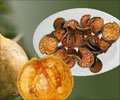Sunlight plus low plasma levels of antioxidants could mean risk of eye disease in elders, a new study shows.
Sunlight plus low plasma levels of antioxidants could mean risk of eye disease in elders, a new study shows.
The combination of low levels of antioxidants and blue light exposure from the sun is associated with certain forms of age-related macular degeneration (AMD), according to a report in the October issue of Archives of Ophthalmology, one of the JAMA/Archives journals."The retina is vulnerable to the damaging effects of light," the authors write as background information in the article. "While wavelengths in the UV radiation range are largely absorbed by the cornea and lens, the retina is exposed to visible light, including blue light." Animal and laboratory studies suggest blue light may damage the retina and contribute to the development of AMD, which occurs when the area of the retina (macula) responsible for sharp vision deteriorates.
Antioxidant enzymes—including vitamins C and E, the carotenoids (lutein and zeaxanthin) and zinc—may protect against the harmful effects of blue light on the retina. Astrid E. Fletcher, Ph.D., of the London School of Hygiene & Tropical Medicine, and colleagues measured levels of these nutrients in the blood of 4,753 older adults (average age 73.2) who were part of the European Eye Study. Participants also were interviewed about their lifetime sunlight exposure and had photographs taken of their retinas to detect AMD.
Of the 4,400 participants with complete information available, 2,117 did not have AMD, 101 had neovascular (advanced, involving the formation of new blood vessels) AMD and 2,182 had early-stage AMD. Overall, there was no association between blue light exposure and neovascular or early AMD. However, blue light exposure was associated with neovascular AMD in the one-fourth of individuals with lowest antioxidant levels.
"In particular, the combination of blue light exposure in the presence of low levels of zeaxanthin, alpha-tocopherol [vitamin E] and vitamin C was associated with a nearly four-fold odds ratio of neovascular AMD," the authors write.
Key recommendations from the results include ensuring the intake of key antioxidants, which can be accomplished by consuming recommended dietary intake levels of vitamin C and zinc and increasing consumption of carotenoid-rich fruits and vegetables, the authors note. In addition, individuals should take steps to reduce the exposure of the retina to blue light, such as wearing broad-brimmed hats and sunglasses when outdoors.
Advertisement
Source-Medindia
GPL/SK














